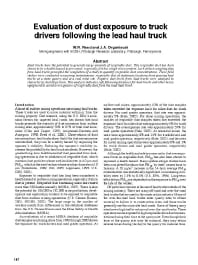Mining Publication: Evaluation of Dust Exposure To Truck Drivers Following The Lead Haul Truck
Original creation date: February 2005
Authors: WR Reed, JA Organiscak
NIOSHTIC2 Number: 20026390
2005 SME Annual Meeting, February 28 - March 2, Salt Lake City, Utah, preprint 05-10. Littleton, CO, Society for Mining, Metallurgy, and Exploration, Inc., 2005 Feb; :1-9
Haul trucks have the potential to generate large amounts of respirable dust. This respirable dust has been shown to be a health hazard to personnel, especially if it contains a high silica content. Lack of dust sampling data from haul trucks prompted the completion of a study to quantify respirable dust concentrations. These field studies measured instantaneous respirable dust at stationary locations from passing haul trucks at a stone quarry and a coal mine site. Fugitive dust levels from haul trucks were analyzed to characterize dust dispersion. This analysis will indicate safe following distances for haul trucks and other heavy equipment to avoid overexposure to respirable dust from the lead haul truck.

NIOSHTIC2 Number: 20026390
2005 SME Annual Meeting, February 28 - March 2, Salt Lake City, Utah, preprint 05-10. Littleton, CO, Society for Mining, Metallurgy, and Exploration, Inc., 2005 Feb; :1-9
- Direct-on-filter Analysis for Respirable Crystalline Silica Using a Portable FTIR Instrument
- Dust Considerations When Using Belt Entry Air to Ventilate Work Areas
- The Effects of Water Spray Placement for Controlling Respirable Dust and Face Methane Concentrations
- Equivalency of a Personal Dust Monitor to the Current United States Coal Mine Respirable Dust Sampler
- Investigation of Coal Properties and Airborne Respirable Dust Generation
- Laboratory Evaluation of Pressure Differential-based Respirable Dust Detector Tube
- Laboratory Testing To Quantify Dust Entrainment During Shield Advance
- New Tools To Monitor Personal Exposure To Respirable Coal Mine Dust
- Performance of a Light Scattering Dust Monitor at Various Air Velocities: Results of Sampling in the Active Versus the Passive Mode
- Relationship of Coal Seam Parameters and Airborne Respirable Dust at Longwalls